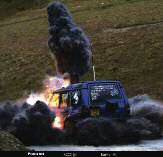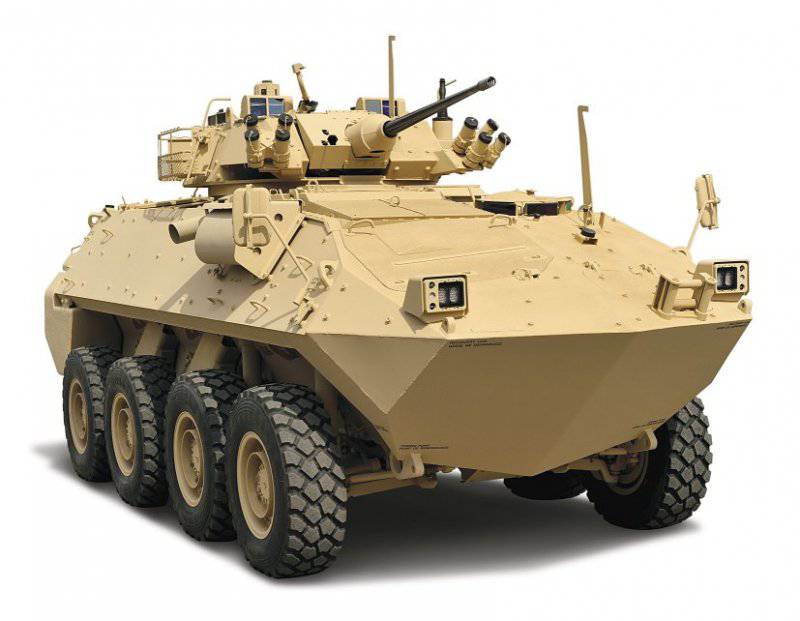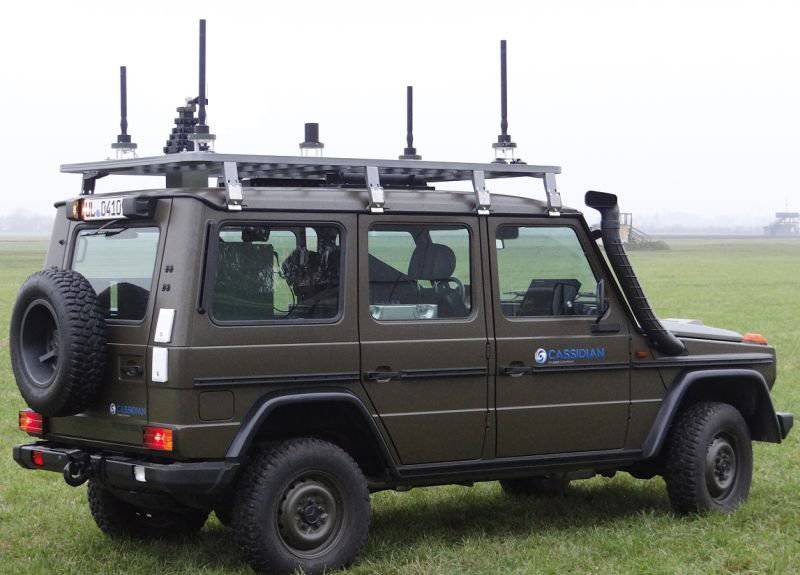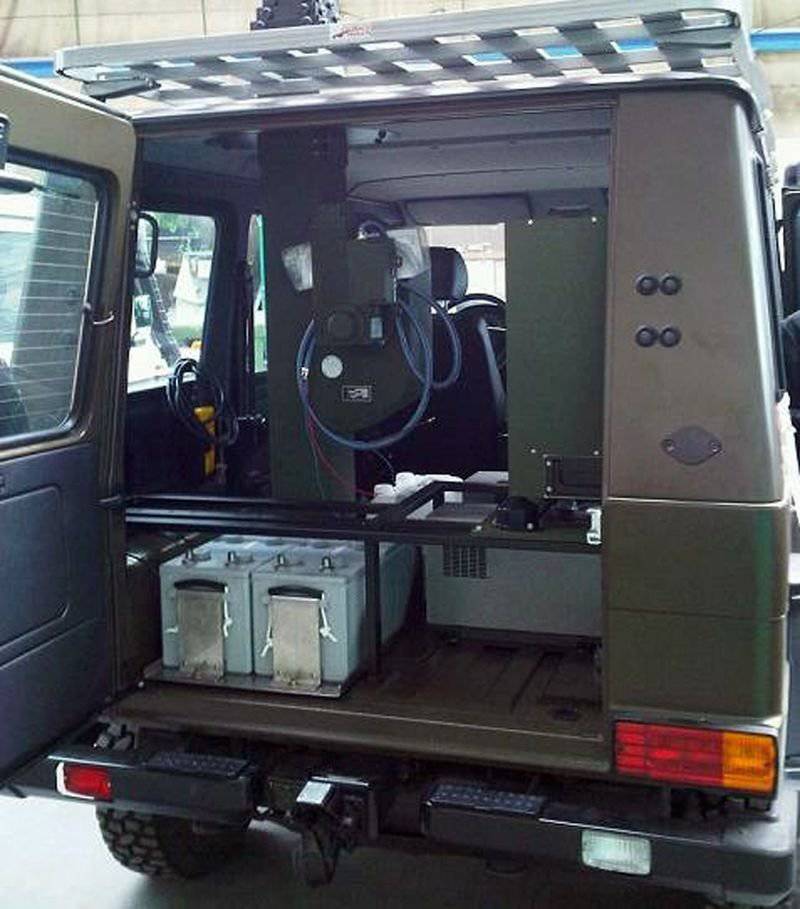Protection for armored vehicles (Part 3)
One of the main threats to war machines comes from the bottom. An explosion under the car can have two types of impact: the first is punching the bottom of the car and, as a result, killing those sitting inside, or damage it so that serious injuries are inflicted even without disturbing the integrity of the bottom, the second is tearing the machine off the ground, which leads to the effect Falls, often more dangerous than the acceleration itself caused by the explosion.
Simply put, active resistance to mines or buried IEDs means that the protection system must a) eliminate penetration, b) limit the deformation, c) reduce acceleration on the crew, and d) minimize the height of the vehicle toss.
Passive systems can cope with explosions under the bottom, but this imposes big restrictions, and the main one is an increase in ground clearance, since the maximum pressure decreases in proportion to the square of the distance. Another factor is the shape of the bottom. A typical V-shape allows you to deflect the blast wave and, accordingly, reduce the pressure. The energy-absorbed armor under the car also helps to reduce the impact of the blast wave, but in order to avoid cumbersome decisions there is a compromise between thickness and mass. The simultaneous combination of these three solutions while maintaining optimal ground clearance leads to an increase in overall height, which means greater visibility and a higher center of gravity, negatively affecting the stability of the machine.
If the forces applied to a sheet of metal and directed upward and downward are equally balanced, it will not move or deform. Putting this theory into practice is not an easy task, especially when the upward impulse is caused by a mine explosion and there is virtually no time for a response. However, for Roger Sloman, managing director of the British company Advanced Blast & Ballistic Systems (ABBS), when watching the video of the explosive tests in slow motion, it became clear that the notion of "no time" was wrong. From the moment the shock wave hits the bottom of the car and the moment the car starts moving and lifts off the ground, it takes 5 to 6 milliseconds, which is quite enough to trigger the opposing force - basically a commensurate downward force. Thus, it was necessary to find some kind of energy solutions that do not greatly affect the size and weight of vehicles - either based on recoil (rollback) systems or rocket engines. The latter were selected as the preferred solution. With funding from the British Department of Defense, ABBS began developing a multi-product family of products. It included the VGAM (Vehicle Global Acceleration Mitigation) system, which reduces the threat of general acceleration, and the VAFS (Vehicle Armored Floor Stabilization) system, which reduces or eliminates bottom deformation.

The photo clearly shows a column of smoke emerging from the central tube. At the same time, the car almost never leaves the ground. This demonstrates that downward force can reduce overall upward acceleration.

In recent years, several companies have presented a variety of bottom protection solutions, often based on V-shaped blast boxes. For its part, General Dynamics Land Systems has developed for its newest versions of Stryker machines what it calls the “twin V-shaped hull”. No details about this were given, but the army first bought the first batch of 450 machines Stryker equipped with this system, and then the second batch of 292 machines. Currently, a modernization kit is offered for LAV II (in the photo), since upgrading to 40% is cheaper compared to the cost of a new car.
The number of actuators in these systems varies based on the type of vehicle and the desired result; A single actuator is used in VAFS systems, whereas for VGAM systems, as a rule, several devices are provided. The pressure and acceleration sensors provide the computer with all the necessary parameters, ensuring that every jet engine is turned on at the right moment and with the proper workload and has the exact period of time to cope with the explosive energy and pulse duration, as well as the position of the explosive device under the bottom. Mass and volume are also sensitive variables in this equation. However, according to ABBS, VAFS technology would allow reducing the “V” angle, which would allow lowering the bottom and, therefore, the center of gravity, and thus reducing the profile of the car or increasing the internal volume. Its increase would noticeably compensate for the presence of supports containing or supporting jet engines and distributing forces on the bottom. The VAFS technology could also destroy the floor so that there is no contact with the legs of the crew and reduce the acceleration of loose objects. A cellular material is added between the V-shaped lower part and the actual floor. All energetic materials used in the system are insensitive explosives, and the jet engine housings are bullet-proof. Initial tests confirmed the basic principles of the system, ABBS is currently looking for a partner to move from concept to production. Around March, 2013, the company planned to demonstrate the capabilities of the technology after undermining 8-kg mines under the bottom of a Jankel Jeep 8 with close to serial rocket engines and a control system (at the moment there is no information about these tests). ABBS expects that a three-ton armored car will not tear itself off or “almost” will not lift off the ground with minimal or zero deformation of the internal bottom.
Tencate Advanced Armor developed an active anti-explosion protection system ABDS (Active Blast Defense System) in cooperation with the Danish company ABDS A / S. Development began in 2010, and in March 2011, the first tests were conducted. At the end of 2011, Tencate acquired all ABDS A / S shares, giving birth to TenCate Active Protection ApS. There are not so many details about this system. It is known that ABDS should be based on two moving masses, which are accelerated downwards in order to reduce the acceleration of the vehicle upwards, thereby reducing the amount of blast energy transmitted to passengers. The system is installed under the bottom of the machine and includes a specially created system for launching and activating TAS (Trigger and Activation System). It issues stable, safe, high-speed automatic commands to activate proprietary countermeasures and an accurate programmable structural and biomechanical response mode. An extensive test series was conducted, including tests on the M15 113-ton BTR. According to TenCate, the ABDS system can increase mine protection up to 5 and 6 Levels, it can be installed on a wide range of light, medium and heavy platforms.
A different solution was developed by the German company Drehtainer. Her Zero Shock system is based on a second bottom, which is suspended on steel cables inside a vehicle or a security module; the second bottom is placed in 200 mm from the armored bottom, quite enough to eliminate the effect of the deformation of the main bottom on it. In the event of an explosion, the sensors activate ejectors, like in an airbag, in 0,4 milliseconds. After that, the bottom "floats", a time sufficient for a significant reduction in acceleration. According to the company Drehtainer, the forces acting on the bottom make up only 20% of the forces allowed by the NATO standards STANAG, which allows, therefore, not only to avoid injuries, but also to install the seats directly on the bottom itself, rather than hanging them to the walls. The system has been tested in Germany, the UK and Canadian military centers. The Netherlands tested the M113 armored personnel carrier, equipped with a second bottom, undermining an anti-tank mine under it. The Zero Shock system was installed in transport containers supplied by the Swiss army, and this system also stands in containers for transporting the wounded, which are delivered to the German Bundeswehr in 2013 year. Drehtainer is currently working on a new solution that could neutralize the overall acceleration of the machine itself.
Passive underbody protection systems
Let us turn to passive systems. Oto Melara worked on the protection of the bottom in two funded research programs, one international and one national, by developing a new protection kit designed to neutralize high-explosive and shell-forming charges (“shock cores”). The PPS threat has become the goal of an international development program, which included Italy, the Netherlands, the Czech Republic and Spain, as well as defense agencies and industrial enterprises. Oto Melara has led this program. As a standard threat, an analogue of the TMRP-6 anti-tank mine with an explosive charge of 5,2 kg of trinitrotoluene and lining with a diameter of 174 mm and a mass of 773 gram was selected. The meeting speed created by this PPS - 1850 m / s. Mina is able to penetrate 400 high-hardness alloy steel in Brinell from 0,8 distance m. With the help of simulations, initial testing was carried out, while gradually increasing the power of the threat and the size of armor panels. During the simulation, about 20 different solutions were tested, the dimensions of the panels varied between 600 × 600 mm and 1500 × 1500 mm. Mass and volume are the two main elements necessary to neutralize the threat; a compromise is needed here so that you can add booking kits to the bottom of the vehicle. The optimal solution should have the largest mass-volume coefficient, that is, it is the minimum mass and volume for a given level of protection. However, these two concepts, as a rule, contradict each other. Solutions developed during the test phase had unique mass-volume coefficients. One of them was tested in June 2012 of the Italian Army Brigade M113, the charge was placed at a distance of 410 mm. The bottom of the armored personnel carrier was pierced by this PPS, while two dummies with a full set of measuring sensors, seated on energy-absorbing seats, showed that the ultimate loads were much lower than acceptable values. With the assistance of the national research fund, Oto Melara has implemented a similar program aimed at neutralizing the threat of a high-explosive explosion. At the next stage, the results obtained were combined in order to develop a solution against both threats. It should be inexpensive, its mass should be compatible with vehicles for transporting personnel, it should be easily installed on new combat or logistics vehicles, as well as on already existing vehicles. Oto Melara did not take the path of mass and strength, but investigated the interaction between the blast wave and the defense, as well as the near-acoustic propagation of the blast wave in non-uniform armor in order to obtain high levels of protection with a limited mass. The goal was to achieve with a maximum weight reduction of almost one hundred percent protection compared to the two separate solutions mentioned above.


Smart Scout system installed on the car G-Wagen
Jamming
While not much can be done against a rocket that is already flying along its path, in addition to using some of the devices described in this article, much more could be said about so-called improvised explosive devices (IEDs). Some extremely clever and rather impressive, if not slightly frightening, decisions are also described here, but they are more likely solutions aimed at “patching holes”, neutralizing the aggressive action that took place, and not anticipatory measures.
Well, then how is the prevention of aggressive action from the very beginning? The very first measure is to avoid habitual and routine actions. Those places where the enemy begins to wait for you. But sometimes there is no alternative, in which case the intelligence of intelligence systems should have the advantage to detect the "installers" of bombs. But it’s understandable that if we have a lot of problems even in the fight against illegal immigrants and smugglers who illegally cross our well-defined borders, what can we say about tracing the rebels who bomb bombs at night on the desert trail!
However, unlike RPGs, buried or roadside bombs are activated from a distance, either using television controls or telephones, which in turn means that some of the machines in the column could be equipped with active radio-electronic suppression stations (silencers), eg. Easier said than done, because mufflers can adversely affect their own radio stations, weapons and other systems (not to mention the electronics of the vehicle itself!), Especially at a time when soldiers are equipped with more and more electronic devices. Therefore, silencers, as a means of struggle, it is always necessary to modernize not only with regard to potential threats, but also with regard to our own systems in order to be sure that they do not stall or fail at all.
The latest development from the company Cassidian processes large amounts of data, which is consistent with the requirements set out above. The system, called the Smart Scout, was shown on the G-Wagen car. She constantly analyzes the electromagnetic environment and uses the necessary countermeasures. According to Cassidian, the silencer “uses the new ultra-fast intelligent jamming technology Smart Responsive Jamming Technology to significantly increase the level of protection. This system identifies and classifies radio signals designed to activate roadside bombs. Then it begins to emit mute signals in real time, precisely matched to the enemy frequency band. Thus, thanks to the new digital receiver and signal processing technologies, it is quite possible to achieve a response time much less than a millisecond. ”
- Alex Alexeev
- Armada Compendium Armored Vehicles Protection 2013
- Protection for armored vehicles (Part 1)
Protection for armored vehicles (Part 2)
Protection for armored vehicles (Part 3)
Protection for armored vehicles (Part 4)
Protection of armored vehicles (5 final part)
Information